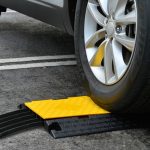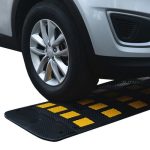Overview
Introduction to traffic management
Traffic management plays a crucial role in ensuring the smooth flow of vehicles and pedestrians on roads. It involves the implementation of various measures to regulate and control the movement of traffic, with the aim of minimizing congestion, enhancing safety, and improving overall efficiency. One innovative solution that has gained popularity in recent years is the use of rubber blocks for traffic management. These durable and cost-effective blocks are designed to provide effective separation of lanes, pedestrian pathways, and parking areas. They are easy to install and can be customized to meet specific traffic management needs. In addition to their functionality, rubber blocks also offer environmental benefits as they are made from recycled materials. With their versatility and sustainability, rubber blocks have become a preferred choice for traffic management projects across the globe.
Importance of durable and cost-effective solutions
In the field of traffic management, durable and cost-effective solutions play a crucial role. With the increasing need for efficient traffic control and management, it is essential to have solutions that can withstand the test of time and provide long-lasting benefits. Rubber blocks have emerged as a popular choice for traffic management due to their durability and cost-effectiveness. These blocks are made from high-quality rubber materials that are designed to withstand heavy traffic and extreme weather conditions. They are also easy to install and maintain, making them a practical and efficient solution for traffic management. By opting for durable and cost-effective solutions like rubber blocks, cities and municipalities can effectively manage traffic flow, reduce accidents, and improve overall road safety.
Role of rubber blocks in traffic management
Rubber blocks play a crucial role in traffic management due to their durability and cost-effectiveness. These blocks are commonly used in various traffic control measures such as speed reduction, lane separation, and pedestrian safety. The rubber material provides excellent resistance to wear and tear, making it ideal for withstanding heavy vehicular traffic. Additionally, rubber blocks are easy to install and can be quickly repositioned as needed. Their bright colors and reflective properties enhance visibility, ensuring that drivers can easily identify and navigate through traffic lanes. Moreover, rubber blocks are environmentally friendly as they can be recycled and reused, reducing waste and promoting sustainability in traffic management practices. Overall, the use of rubber blocks in traffic management offers a reliable and cost-effective solution for maintaining safe and organized roadways.
Benefits of Rubber Blocks in Traffic Management
Enhanced safety
Traffic management is a critical aspect of ensuring the safety of both drivers and pedestrians on the road. Rubber blocks have emerged as a durable and cost-effective solution for enhancing safety in traffic management. These rubber blocks are designed to withstand heavy traffic loads and provide a stable surface for vehicles to drive on. They also offer excellent skid resistance, reducing the risk of accidents caused by slippery road conditions. Additionally, rubber blocks are highly visible due to their bright colors, making them easily noticeable by drivers, especially in low-light conditions. By incorporating rubber blocks into traffic management systems, cities and municipalities can significantly improve safety on their roads while also minimizing maintenance costs.
Reduced maintenance costs
One of the key benefits of using rubber blocks for traffic management is the reduced maintenance costs. Unlike traditional concrete or asphalt materials, rubber blocks are highly durable and long-lasting, requiring minimal repairs or replacements. This not only saves on the cost of materials but also reduces the need for frequent maintenance activities such as patching or resurfacing. Additionally, rubber blocks are resistant to cracking and damage caused by extreme weather conditions, further reducing the maintenance expenses. Overall, the use of rubber blocks in traffic management offers a cost-effective solution that helps in minimizing maintenance costs.
Improved durability
Rubber blocks offer enhanced durability compared to traditional traffic management solutions. The unique composition of rubber blocks allows them to withstand heavy traffic loads and extreme weather conditions without deteriorating or losing their shape. This durability ensures a longer lifespan for the traffic management system, reducing the need for frequent replacements and maintenance. Additionally, rubber blocks are resistant to cracking, chipping, and fading, further contributing to their long-lasting performance. With their exceptional durability, rubber blocks provide a cost-effective solution for traffic management, saving both time and money in the long run.
Installation and Maintenance of Rubber Blocks
Proper installation techniques
When it comes to ensuring the durability and cost-effectiveness of traffic management systems using rubber blocks, proper installation techniques play a crucial role. The installation process should be carried out by trained professionals who have a thorough understanding of the specific requirements and guidelines. This includes preparing the surface, ensuring proper alignment and spacing of the rubber blocks, and securely fastening them in place. By following these installation techniques, the rubber blocks can effectively withstand the constant traffic load, resist wear and tear, and provide long-lasting performance. Additionally, proper installation techniques contribute to the overall safety and effectiveness of the traffic management system, minimizing the risk of accidents and maximizing the flow of traffic.
Regular inspection and maintenance
Regular inspection and maintenance are crucial for ensuring the durability and cost-effectiveness of traffic management with rubber blocks. By conducting routine inspections, any potential issues or damages can be identified early on and addressed promptly. This helps to prevent further damage and prolongs the lifespan of the rubber blocks. Additionally, regular maintenance, such as cleaning and repositioning, can help maintain the effectiveness of the traffic management system. By investing time and effort into regular inspection and maintenance, organizations can maximize the benefits of using rubber blocks for traffic management while minimizing the need for costly repairs or replacements.
Repair and replacement procedures
In order to ensure the durability and cost-effectiveness of the traffic management system using rubber blocks, it is important to follow proper repair and replacement procedures. When a rubber block becomes damaged or worn out, it should be promptly replaced to maintain the integrity of the system. The damaged block can be easily removed by lifting it with a pry bar or similar tool. Once the old block is removed, a new rubber block can be installed in its place by aligning it with the adjacent blocks and pressing it firmly into position. Regular inspections should also be conducted to identify any potential issues or areas that require repair. By following these repair and replacement procedures, the traffic management system can continue to function efficiently and effectively, providing a durable and cost-effective solution for managing traffic flow.
Case Studies: Successful Implementation of Rubber Blocks
City A: Reducing accidents and congestion
City A has implemented a durable and cost-effective traffic management solution using rubber blocks. These rubber blocks are strategically placed at key intersections and roadways to enhance road safety and reduce accidents. The rubber blocks act as speed breakers, forcing drivers to slow down and adhere to the speed limit. Additionally, they help to control traffic flow and prevent congestion by creating designated lanes and separating different types of vehicles. This innovative approach has proven to be highly effective in reducing accidents and congestion in City A, making it a safer and more efficient city for both pedestrians and drivers.
City B: Cost savings and long-term benefits
Rubber blocks offer significant cost savings and long-term benefits for traffic management in City B. By using rubber blocks instead of traditional concrete barriers, the city can reduce construction and maintenance costs. Rubber blocks are durable and require less frequent replacement compared to concrete barriers, resulting in long-term cost savings. Additionally, rubber blocks are lightweight and easy to transport, making them more cost-effective to install and relocate as needed. Furthermore, rubber blocks provide improved safety for pedestrians and drivers, as they have better impact absorption and reduce the risk of serious injuries in case of accidents. Overall, the use of rubber blocks in City B’s traffic management system offers both immediate cost savings and long-term benefits in terms of durability, flexibility, and safety.
City C: Sustainable and eco-friendly solution
Rubber blocks are proving to be a durable and cost-effective solution for traffic management in City C. These blocks are made from recycled rubber, making them a sustainable choice. Not only do they provide a safe and reliable way to control traffic flow, but they also contribute to reducing waste and promoting environmental conservation. The use of rubber blocks in City C is a testament to the city’s commitment to finding innovative and eco-friendly solutions for its infrastructure needs.
Conclusion
Summary of the benefits of rubber blocks
Rubber blocks offer several advantages for traffic management. Firstly, they are highly durable, capable of withstanding heavy traffic and harsh weather conditions. This ensures their long-term effectiveness and reduces the need for frequent replacements. Additionally, rubber blocks are cost-effective as they require minimal maintenance and have a longer lifespan compared to traditional traffic management solutions. They also provide improved safety by offering better traction and reducing the risk of skidding. Furthermore, rubber blocks are environmentally friendly as they can be recycled and reused, contributing to sustainable practices. Overall, the use of rubber blocks in traffic management offers a reliable, long-lasting, and cost-effective solution with numerous benefits.
Importance of investing in durable and cost-effective traffic management solutions
Effective traffic management is crucial for ensuring the safety and efficiency of our roadways. Investing in durable and cost-effective solutions, such as rubber blocks, is of utmost importance. Rubber blocks offer several advantages over traditional traffic management materials. They are highly durable and can withstand heavy traffic and harsh weather conditions, ensuring long-lasting performance. Additionally, rubber blocks are cost-effective as they require minimal maintenance and have a longer lifespan compared to other materials. By investing in durable and cost-effective traffic management solutions like rubber blocks, we can enhance road safety, reduce maintenance costs, and promote sustainable transportation infrastructure.
Future prospects and advancements in rubber block technology
Rubber block technology has shown immense potential in the field of traffic management. With its durability and cost-effectiveness, rubber blocks have become a popular choice for road infrastructure projects. However, the future prospects of rubber block technology go beyond just traffic management. Ongoing research and development are focused on enhancing the performance and sustainability of rubber blocks. Advancements in materials and manufacturing processes are being explored to improve the strength and longevity of rubber blocks, making them even more reliable for long-term use. Additionally, efforts are being made to incorporate smart technologies into rubber blocks, such as embedded sensors and communication systems, to enable real-time monitoring and data collection. These advancements in rubber block technology are expected to revolutionize the way traffic is managed, ensuring safer and more efficient road networks in the future.








